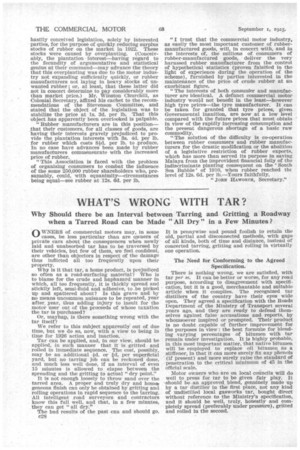WHAT'S WRONG WITH TAR?
Page 12

If you've noticed an error in this article please click here to report it so we can fix it.
Why Should there be an Interval between Tarring and Gritting a Roadway when a Tarred Road can be Made "All Dry" in a Few Minutes ?
0WNERS of commercial motors may, in some cases, be less particular than are owners of private cars about the consequences when newly laid and unabsorbed tar has to be traversed by their vehicles, but few of them, we feel confident, are other than objectors in respect of the damage thus inflicted all too frequently upon their property.
Why is it that tar, a home product, is prejudiced so often as a road-surfacing material? Who is to blame for the crude and haphazard manner in which, all too frequently, it is thickly spread and stickily left, semi-fluid and adhesive, to .be picked up and spattered about? Is this grave and by no means uncommon nuisance to be repeated, year after, year, thus adding injury to insult for the motor user out of the proceeds of whose taxation the tar is purchased?
Or, mayhap, is there something wrong with the tar itself?
We refer to this subject apparently. out of due time, but we do so, now with a view to being in time for 1926 action and inaction.
Tar can be applied, and, in our view, should be applied, in such manner that it is gritted and rolled in immediate sequence. The cost, possibly, may be an additional id. OT id. per superficial yard, but no tarring job can be reckoned done, and much less well done, if an interval of even 15 minutes is allowed to elapse between the spreading and the gritting to actual "dry point."
It is not enough loosely to throw sand over the tarred area. A proper and truly dry and home* geneous finish can only be obtained by gritting and rolling operations in rapid sequence to the tarring. All intelligent road surveyors and contractors know this full well, and that, in a few minutes, they can get "all dry."
The bad results of the past can and should go. 028 It is pennywise and pound foolish to retain the old, partial and disconnected methods, with gaps of all kinds, both of time and distance, instead of concerted tarring, gritting and rolling in virtually one operation.
The Need for Conforming to the Agreed Specification.
There is nothing wrong, we are satisfied, with tar per se. It can be better or worse, for any road purpose, according to disagreement with specification, but it is a good, merchantable and suitable article when it complies. The recognized tar distillers of the country have their eyes wide open. They agreed a specification with the Roads Department of the Ministry of Transport several years ago, and they are ready to defend themselves against false accusations and reports, by whomsoever inspired or prompted. Their product is no doubt capable of further improvement for the purposes in view : the best formuhe for blending varying percentages of bitumen with tar remain under investigation. It is highly probable, in this most important matter, that native bitumen will be employed to replace oil bitumen as a stiffener, in that it can more surely fix any phenols • (if present) and more surely raise the standard of penetration to the critical minimum of 45 in the official scale.
Motor owners who are on local councils will do well to press for tar to be given fair play. It should be an approved blend, genuinely made up by a tar distiller in the first place, not any kind of undistilled local gasworks tar, bought direct without reference to the Ministry's specification, and it should be well, truly, honestly and completely spread (preferably under pressure), gritted and rolled in the second.




























